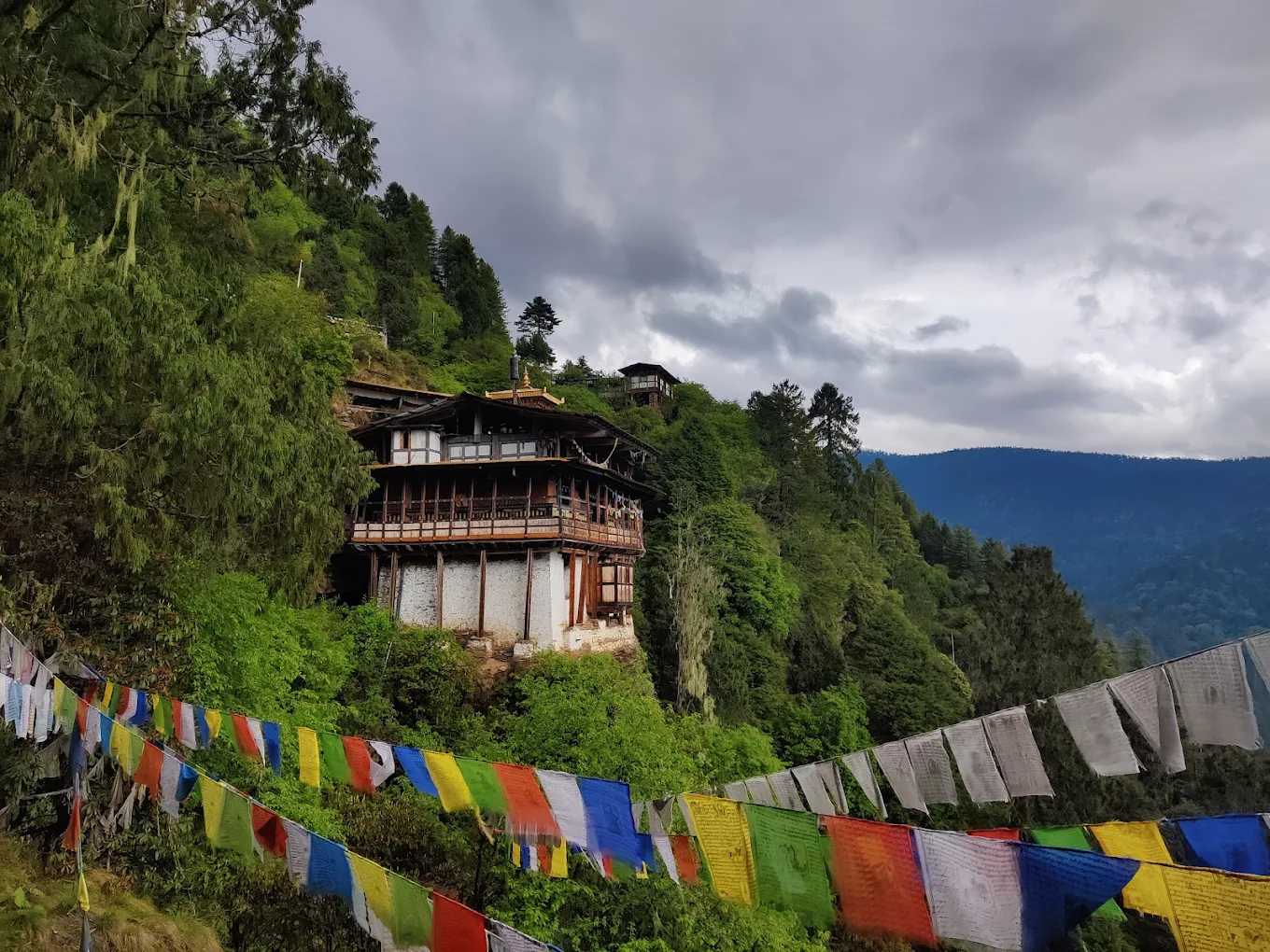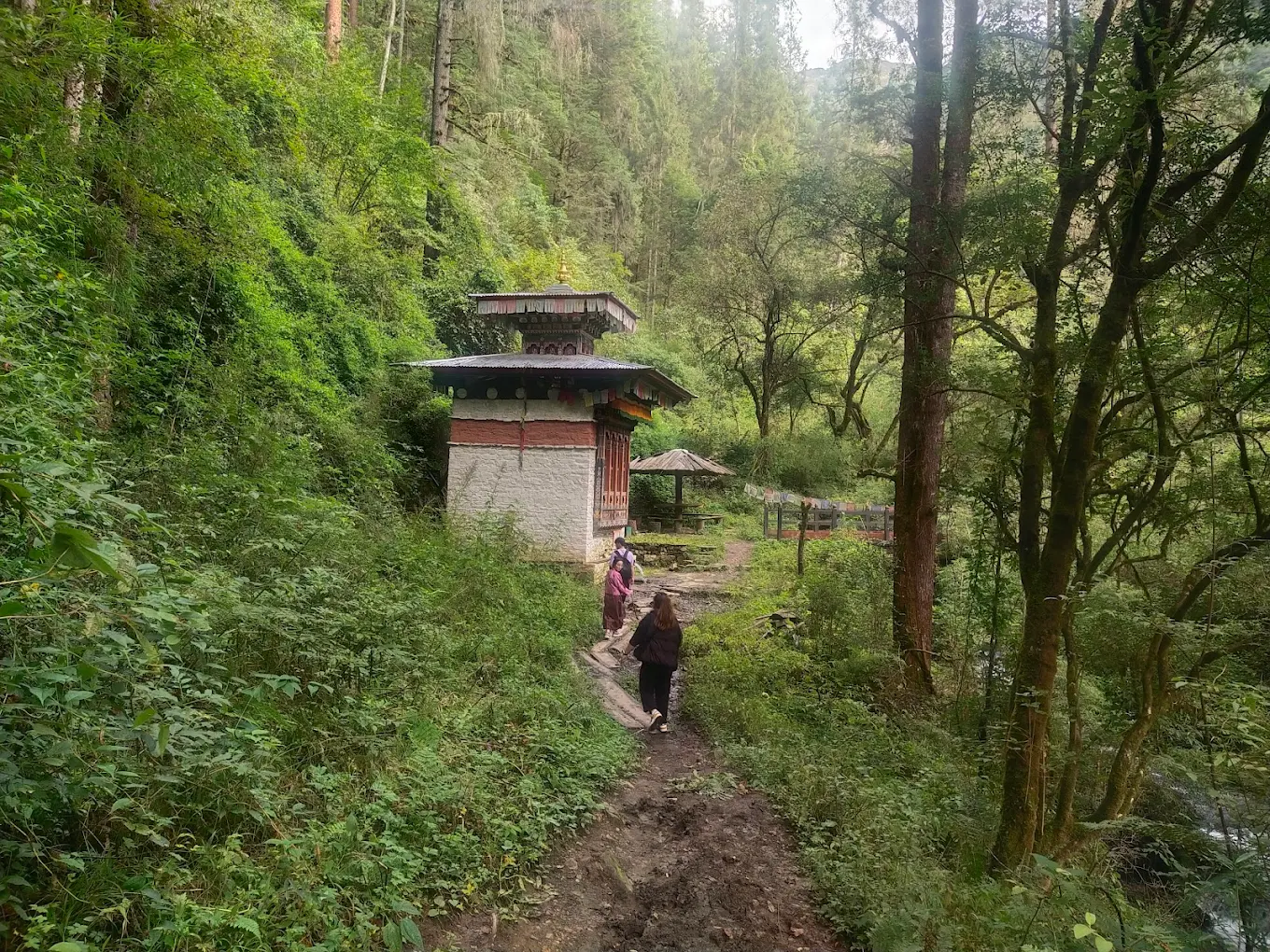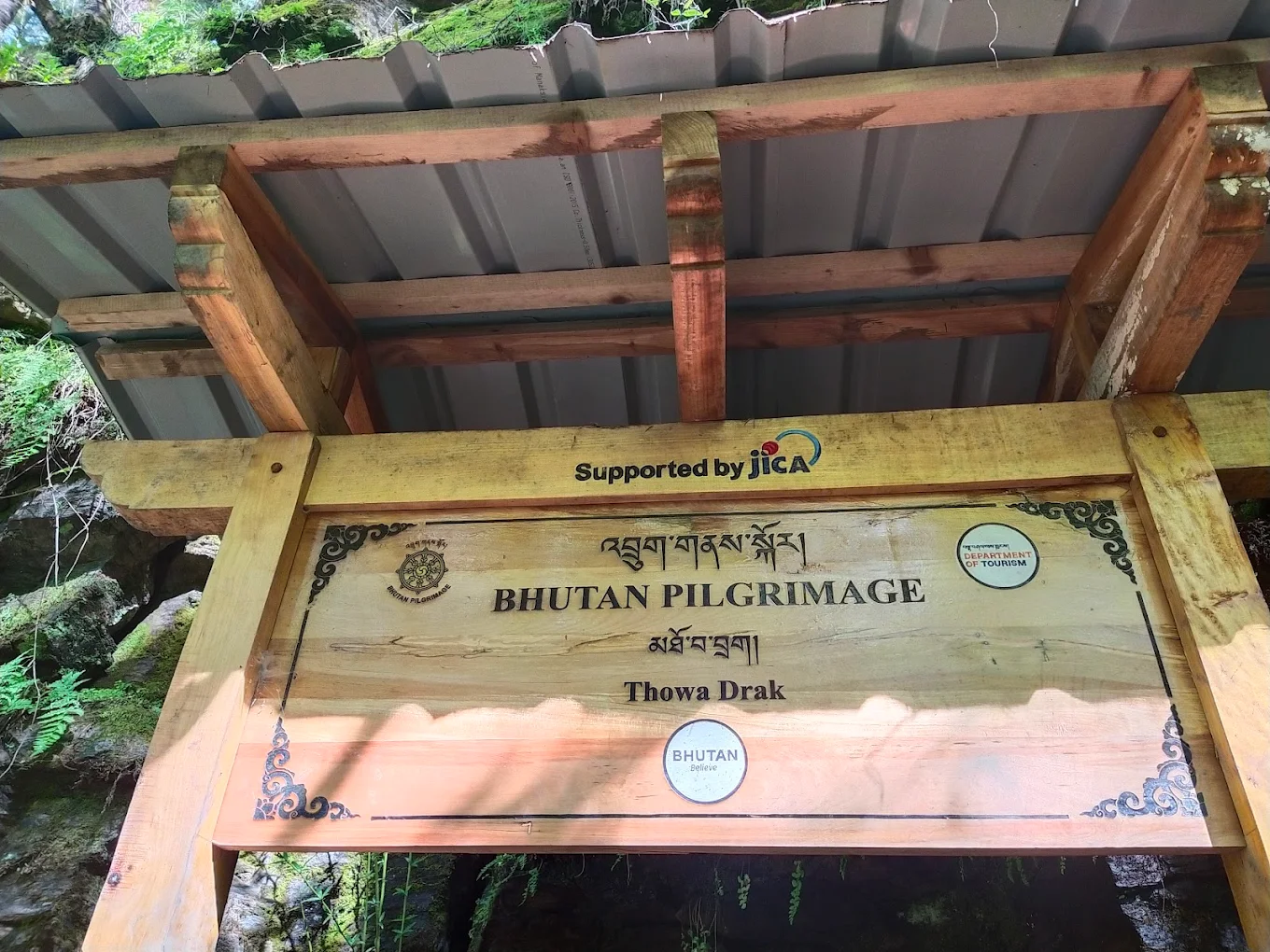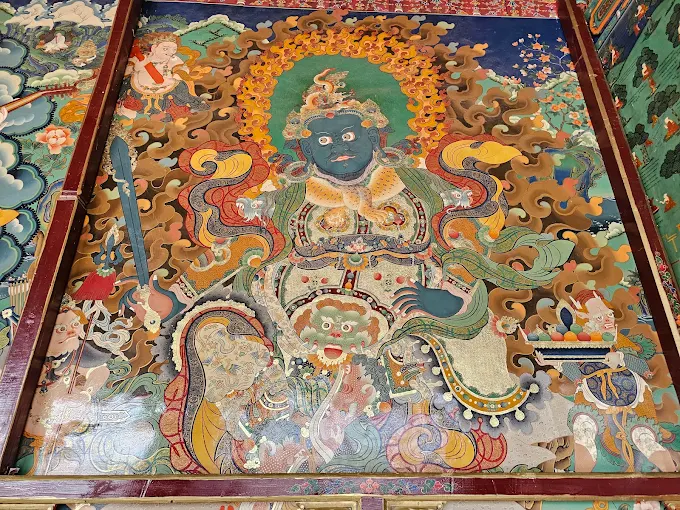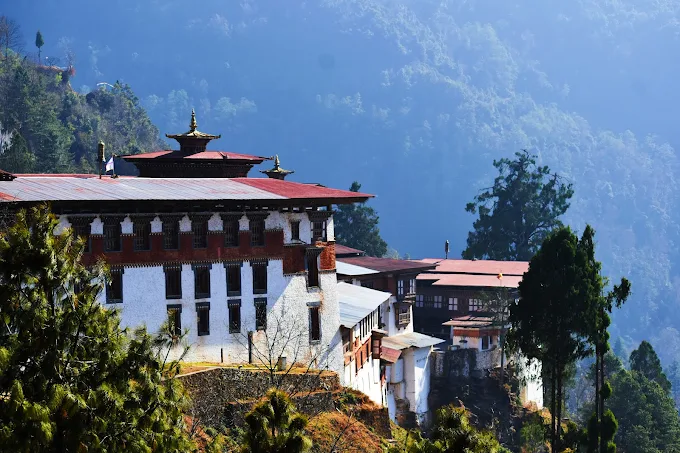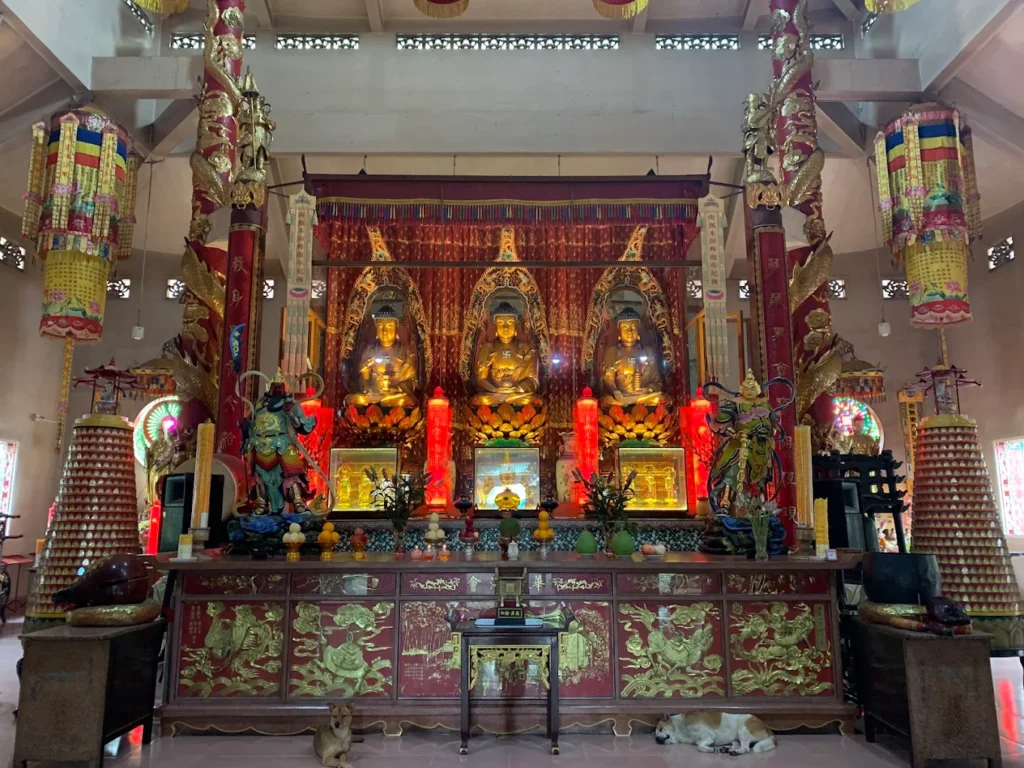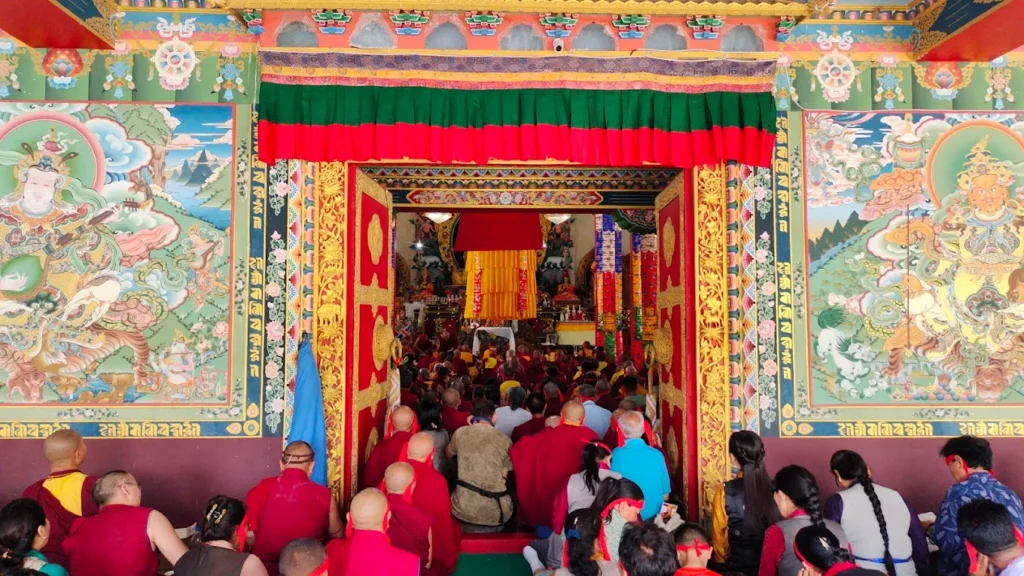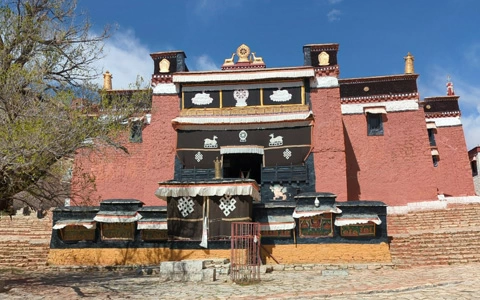Thowadra Monastery: The High Rock of Bumthang’s Sacred Serenity
In the remote Tang Valley of Bumthang, where the wind carries whispers of ancient mantras through towering pines, Thowadra Monastery (dgon pa) clings to a cliff at 3,400 meters, a sentinel of Nyingma spirituality. Monks in maroon robes light butter lamps in a cave where Guru Rinpoche meditated, their chants mingling with the trickle of a sacred spring (Drupchhu). Founded in 1238 by Drukpa Kagyu master Lorepa, this hermitage, now a Nyingma retreat, marks one of Guru Rinpoche’s sacred meditation cliffs. A stone throne, etched with divine imprints, anchors the site’s spiritual core, drawing pilgrims to its solitude. Thowadra’s fasting festivals and Dzogchen practices offer a glimpse into Bhutan’s profound Buddhist heritage, where the high rock’s isolation fosters a timeless quest for enlightenment amidst the Himalayan stillness.
Whispers of the High Cliff: Overview and Significance
Introduction to Thowadra Monastery
Thowadra Monastery, perched on a cliff in Tang Valley, Bumthang Dzongkhag, Bhutan, is a sacred Nyingma hermitage, revered as one of Guru Rinpoche’s meditation sites. Established in 1238 by Lorepa of the Drukpa Kagyu lineage, it transitioned to Nyingma in the 18th century under Changchub Gyeltsen, emphasizing Dzogchen, a practice for realizing the mind’s innate purity. At 3,400 meters, its remote location enhances its role as a retreat for monks and pilgrims seeking solitude. Known for its Guru Rinpoche cave, stone throne, and sacred spring, Thowadra holds spiritual significance as a place where the 8th-century master subdued local deities. A cultural beacon, it preserves Bhutanese rituals and oral traditions, inviting global seekers to its serene cliffs.
- Religious Identity: Nyingma, with Drukpa Kagyu origins, centered on Dzogchen.
- Cultural Role: Preserves Bhutanese Buddhist heritage and oral narratives.
- Unique Trait: Cliffside cave with Guru Rinpoche’s imprints and sacred spring.
Historical Journey
Thowadra’s history began in the 8th century when Guru Rinpoche meditated in its cave, leaving a wooden bird to expel an evil king from Khenpajong beyul, a hidden valley. Lorepa, a Drukpa Kagyu lama, founded the monastery in 1238, building a hermitage sanctified by Longchenpa and Dorje Lingpa. By the 18th century, Changchub Gyeltsen, a disciple of Jigme Lingpa, established a Nyingma community, aligning it with Longchen Nyingthik teachings. Managed by Trongsa Rabdey since the 19th century, Thowadra survived a 1983 fire, with restoration in 2005 preserving its relics. Today, it remains a retreat for Dzogchen practitioners, hosting small monastic communities.
- 8th Century: Blessed by Guru Rinpoche, per oral traditions.
- 1238: Founded by Lorepa, verified by Bhutan Cultural Atlas.
- 18th Century: Nyingma community established by Changchub Gyeltsen.
- 2005: Restored post-1983 fire, per Trongsa Rabdey records.
Cultural Significance
Thowadra is a cultural jewel in Bumthang, safeguarding Nyingma chants and oral tales of Guru Rinpoche’s feats. Its fasting festivals (Nyungne), held annually, draw local devotees, reinforcing community bonds. The monastery’s cave, used by masters like Longchenpa, inspires Bhutanese literature and thangka art. Its stone throne and sacred spring, linked to Guru Rinpoche and Gelongma Pelmo, are revered relics, attracting scholars and pilgrims. Thowadra’s cliffside setting embodies Bhutan’s spiritual harmony with nature, a draw for eco-conscious visitors.
- Ritual Preservation: Hosts Nyungne fasting festivals.
- Artistic Influence: Inspires thangka depictions of Guru Rinpoche.
- Sacred Relics: Cave and throne draw scholarly interest.
Unique Legacy
Thowadra’s cliffside location, at 3,400 meters, is its hallmark, symbolizing detachment and ideal for Dzogchen retreats. The Guru Rinpoche cave, with his imprints, is a spiritual focal point, believed to radiate blessings. Oral traditions recount a wooden bird and Dakini songs, preserved by local monks. The monastery’s isolation, accessible only by a steep trek, enhances its mystique, marking the entrance to Khenpajong beyul.
- Cliffside Solitude: Enhances meditative focus, unique in Tang Valley.
- Guru Rinpoche Cave: Sacred imprints, verified locally.
- Khenpajong Beyul: Marks a hidden valley entrance.
Community and Global Impact
Thowadra serves Tang’s farmers, offering pujas for prosperity and health. Monks teach Buddhist ethics to local youth, fostering cultural continuity. Globally, it attracts Nyingma practitioners for retreats, though its remote access limits visitors. Its conservation efforts, protecting Tsari Nguma bamboo, align with Bhutan’s environmental ethos, noted by regional eco-groups. Oral histories, shared via Bhutanese scholars, reach international audiences through the Journal of Bhutan Studies.
- Local Engagement: Pujas for community well-being.
- Youth Education: Buddhist teachings for Tang children.
- Global Reach: Limited retreats, academic publications.
Historical Anecdotes
Local lore, recorded in monastic annals, tells of Guru Rinpoche using a wooden bird to expel a king from Khenpajong, leaving imprints in the cave. Another tale describes Gelongma Pelmo, a leper nun, meditating there, her prayers blessing the spring. These stories, verified by Bumthang elders, enrich Thowadra’s spiritual narrative.
- Wooden Bird: Guru Rinpoche’s feat, per oral traditions.
- Gelongma Pelmo: Blessed the sacred spring.
Social Role
Thowadra hosts harvest blessings, uniting Tang villages with prayers and meals. Monks offer herbal remedies, supporting rural healthcare, and maintain small gardens, aiding sustainability. These efforts, verified by Trongsa Rabdey, strengthen community ties.
- Harvest Blessings: Annual rituals for prosperity.
- Healthcare: Herbal remedies for locals.
- Sustainability: Monastic gardens support Tang.
Artistic Influence
Thowadra’s cave inspires Bhutanese thangkas, depicting Guru Rinpoche’s feats. Its stone throne influences local sculpture, with replicas in Bumthang temples. The hermitage’s minimalist aesthetic shapes regional retreat designs, blending Nyingma simplicity with Bhutanese motifs.
- Thangka Art: Guru Rinpoche’s cliffside scenes.
- Sculpture: Stone throne replicas in local temples.
- Architectural Impact: Influences Bumthang retreat designs.
From Legend to Stone: Transition to Architecture
Thowadra’s historical and cultural legacy, rooted in Guru Rinpoche’s meditation, finds expression in its cliffside architecture. The monastery’s simple stone structure, built around a sacred cave, reflects Nyingma’s focus on spiritual austerity. From the lhakhang’s weathered walls to the stone throne under a cypress, each element supports the site’s role as a Dzogchen retreat, inviting exploration of its sacred spaces and natural harmony.
Sacred Cliffs of Tang: Architectural and Spiritual Features
Iconic Design
Thowadra’s architecture is a minimalist blend of Bhutanese stonework and Nyingma simplicity, clinging to a cliff at 3,400 meters. The three-story lhakhang, built with stone, mud, and timber, covers a rock face, with a roof following the cliff’s gradient. Its bird-neck cornice (ngangpa) and ancient Gyeltshen pinnacle reflect Bhutanese tradition, while the cave’s sanctity defines its spiritual core.
- Cliffside Layout: Enhances retreat solitude.
- Bird-Neck Cornice: Traditional Bhutanese motif.
- Gyeltshen Pinnacle: Ancient, symbolizing victory.
Key Structures
The monastery comprises a main temple (lhakhang), retreat huts, and a lam’s residence. The lhakhang, built around Guru Rinpoche’s cave, is the spiritual heart, with space for circumambulation. Scattered retreat huts, carved into the cliff, support solitary meditation. The lam’s residence, above the lhakhang, oversees rituals. A stone throne under a cypress tree and a sacred spring nearby are revered relics.
- Main Temple: 20 feet by 15 feet, encasing the cave.
- Retreat Huts: 5–7 cliffside rooms for meditation.
- Stone Throne: Guru Rinpoche’s seat, under cypress.
Worshipped Statues
The lhakhang houses a small Guru Rinpoche statue, crafted in bronze with turquoise inlays, depicting him in a meditative pose with a vajra, symbolizing wisdom. Flanking it are clay figures of Avalokiteshvara (Chenrezig), embodying compassion, and Gelongma Pelmo, honoring her meditation. These modest statues, made by local artisans, are central to daily offerings.
- Guru Rinpoche: 2-foot bronze, turquoise-inlaid.
- Avalokiteshvara: 1.5-foot clay, white-hued.
- Gelongma Pelmo: 1-foot clay, unique to Thowadra.
Materials and Techniques
Built with local stone, mud, and timber, Thowadra uses traditional Bhutanese rammed-earth techniques for durability. Artisans from Tang carved wooden beams with mantra inscriptions, blending Nyingma and Bhutanese motifs. The cliff’s natural rock face forms the lhakhang’s rear wall, integrating architecture with nature.
- Stone Walls: Rammed earth, 1.5 feet thick.
- Wooden Beams: Carved with Om Mani Padme Hum.
- Rock Face: Natural cave wall, unadorned.
Signature Elements
The Guru Rinpoche cave, with his imprints, is Thowadra’s iconic feature, used for Dzogchen meditation. The stone throne, under a cypress, bears Dakini marks, revered as a blessing site. The sacred spring, emerging from the rock, is believed to heal ailments, drawing pilgrims.
- Meditation Cave: 10 feet deep, with imprints.
- Stone Throne: Dakini marks, under cypress.
- Sacred Spring: Drupchhu, healing properties.
Lesser-Known Features
A narrow passage between the lhakhang and cliff, known as the “door of the apocalypse,” allows sideways circumambulation, a rare ritual space. Carved mantras on trailside rocks, attributed to Longchenpa, guide pilgrims. A cypress tree above the throne, believed to be Guru Rinpoche’s planting, is a subtle relic.
- Apocalypse Door: Narrow ritual passage.
- Carved Mantras: Longchenpa’s inscriptions.
- Cypress Tree: Guru Rinpoche’s relic.
Preservation Efforts
Post-1983 fire restoration in 2005, led by Trongsa Rabdey, reinforced stone walls with local labor. Community funding maintains the lhakhang, protecting it from monsoon damage. Monks clear trails annually, ensuring pilgrim access, per ABTO records.
- 2005 Restoration: Reinforced stone walls.
- Community Funding: Annual drives for upkeep.
- Trail Maintenance: Monks clear steep paths.
Environmental Integration
Thowadra harmonizes with Tang’s rugged landscape, its cliffside perch minimizing ecological impact. Tsari Nguma bamboo, believed brought from Tibet, surrounds the site, used for ritual protection. The sacred spring supports monastic needs, reflecting Bhutan’s eco-conscious ethos.
- Cliffside Design: Reduces land disturbance.
- Tsari Nguma Bamboo: Ritual and ecological role.
- Sacred Spring: Sustainable water source.
Artisan Narratives
Local artisan Karma Dorji, trained in Bumthang, crafted the Guru Rinpoche statue in 2006, using traditional bronze-casting. Tenzin Wangmo, a Tang elder, carved mantra rocks along the trail, per monastic records. These efforts, verified by Trongsa Rabdey, highlight community craftsmanship.
- Karma Dorji: Cast Guru Rinpoche statue, 2006.
- Tenzin Wangmo: Carved trail mantras, 2005.
- Community Artisans: Local labor for restoration.
Symbolic Details
The lhakhang’s stone walls symbolize impermanence, a Dzogchen teaching. The bird-neck cornice represents Guru Rinpoche’s wooden bird, a protective emblem. The cave’s imprints embody enlightenment’s presence, urging detachment from worldly concerns.
- Stone Walls: Impermanence and austerity.
- Bird-Neck Cornice: Guru Rinpoche’s legacy.
- Cave Imprints: Enlightenment’s mark.
Landscape Integration
Thowadra’s elevated perch offers panoramic views of Tang Valley, enhancing its spiritual ambiance. Mani walls and chortens along the trail connect the monastery to local devotion. The nearby river’s flow inspires meditative calm, complementing Dzogchen practice.
- Panoramic Views: Valley vistas from lhakhang.
- Mani Walls: Devotional trail markers.
- Tang River: Enhances meditative serenity.
From Stone to Spirit: Transition to Rituals
Thowadra’s cliffside architecture, centered on Guru Rinpoche’s cave, creates a sacred space where Nyingma rituals unfold. The lhakhang’s simplicity supports fasting festivals and solitary retreats, inviting monks and pilgrims to engage with Dzogchen’s profound teachings. These practices, rooted in Longchen Nyingthik, bridge the monastery’s physical form with its spiritual essence.
Rhythms of Devotion: Rituals and Practices
Daily Sacred Rites
Monks gather at dawn in the lhakhang, chanting Longchen Nyingthik texts and offering butter lamps before the Guru Rinpoche statue. Evening prayers involve circumambulation around the cave, spinning prayer wheels. Lay devotees join weekly pujas, offering rice and incense, fostering communal devotion, per Trongsa Rabdey records.
- Morning Chants: Longchen Nyingthik, 5 AM.
- Evening Circumambulation: Cave and throne rituals.
- Lay Pujas: Weekly, open to Tang villagers.
Unique Practices
Thowadra’s Nyungne fasting retreats, held annually, are distinctive, with monks and laity fasting for five days to purify karma, guided by Longchen Nyingthik sadhanas. Solitary Dzogchen retreats in the cave, lasting weeks, emphasize direct realization of mind’s nature, a rare practice in Bumthang.
- Nyungne Retreats: 5-day fasting, 1st lunar month.
- Cave Meditation: Dzogchen, 7–21 days.
- Lay Access: Limited fasting retreats for devotees.
Festival Traditions
The Nyungne festival, from the 13th to 17th day of the 1st lunar month (February–March), features fasting, Avalokiteshvara sadhanas, and community offerings of first-harvest grains. The Shakpa festival, on the 10th day of the 9th lunar month (October–November), includes sin-forgiveness rites. Kanjur Daksa, a 21-day scripture recitation in the 2nd lunar month (March–April), promotes well-being, per Bhutan Pilgrimage.
- Nyungne Festival: 5 days, 1st lunar month.
- Shakpa Festival: Sin forgiveness, 9th lunar month.
- Kanjur Daksa: 21 days, 2nd lunar month.
Visitor Engagement
Pilgrims can join morning pujas, lighting butter lamps under monk guidance. Guided cave tours, led by the lam, explain Dzogchen and relic symbolism. Short meditation sessions, offered during festivals, provide hands-on experience, verified by ABTO.
- Puja Participation: Daily, 5 AM, lamp offerings.
- Cave Tours: 30-minute, by lam appointment.
- Meditation Sessions: Festival-based, 1 hour.
Spiritual Community Roles
Monks, led by Thowadrak Lam, conduct pujas, teach Dzogchen, and maintain relics. Lay devotees offer grains for festivals, strengthening ties. Senior monks mentor novices in Longchen Nyingthik, ensuring tradition’s continuity, per Trongsa Rabdey.
- Monastic Roles: 10–15 monks, teaching duties.
- Lay Contributions: Grain offerings for rituals.
- Mentorship: Novices trained in sadhanas.
Interfaith Connections
Thowadra’s rituals incorporate Bhutanese folk elements, such as offerings to local deities, reflecting syncretism. During Nyungne, Hindu visitors from southern Bhutan join, honoring shared compassion, a verified practice fostering harmony.
- Folk Syncretism: Offerings to Tang spirits.
- Hindu Participation: Nyungne attendance, verified.
- Shared Values: Compassion unites faiths.
Ritual Symbolism
Butter lamps symbolize wisdom dispelling ignorance, a Dzogchen principle. Fasting during Nyungne represents purification, aligning with Avalokiteshvara’s compassion. The cave’s circumambulation teaches impermanence, a core Nyingma tenet.
- Butter Lamps: Wisdom and clarity.
- Fasting: Purification and compassion.
- Circumambulation: Impermanence and devotion.
Seasonal Variations
Winter pujas focus on protection, with extended Chenrezig chants for safety. Summer festivals emphasize Guru Rinpoche, with outdoor offerings. Monsoon retreats in the cave intensify, leveraging solitude, per monastic records.
- Winter Rituals: Protection-focused, Chenrezig chants.
- Summer Festivals: Guru Rinpoche celebrations.
- Monsoon Retreats: Enhanced cave meditations.
Monastic Life
Monks rise at 4:30 AM for meditation, followed by pujas and Longchen Nyingthik study. Afternoons involve trail maintenance or teaching youth. Evenings end with cave circumambulation, maintaining a disciplined life, per Trongsa Rabdey.
- Daily Schedule: Meditation, study, service.
- Community Service: Teaching Tang youth.
- Discipline: Aligned with Nyingma vows.
From Ritual to Journey: Transition to Visitor Information
Thowadra’s rituals, from fasting festivals to cave meditations, invite pilgrims to immerse in its spiritual depth. The monastery’s remote cliffside, accessible only by a challenging trek, welcomes dedicated travelers with practical guidance. Exploring its sacred spring and stone throne offers a transformative experience, grounded in Nyingma’s timeless teachings and Tang’s serene landscape.
Pathways to the High Rock: Visitor Information
Navigating to Thowadra Monastery
Thowadra Monastery is located in Tang Valley, Bumthang Dzongkhag, Bhutan, a 4-hour trek from Ugyenchoeling village. From Jakar, drive 45 km to Tang (1.5 hours), then follow a dirt road to Karap suspension bridge. The trail climbs steeply past chortens and mani walls, taking 3–4 hours uphill, per Bhutan Pilgrimage.
- Route from Jakar: 45 km drive, 4-hour trek.
- Landmarks: Karap bridge, white chorten.
- Trail Condition: Steep, no vehicular access.
Address of Thowadra Monastery
- English: Thowadra Monastery, Tang Valley, Bumthang Dzongkhag, Bhutan.
- Dzongkha: མཐོ་གྲགས་དགོན་པ། ཐང་ལུང་པ། བུམ་ཐང་རྫོང་ཁག། བྷུ་ཊན།
- Coordinates: Approximate GPS 27.65° N, 90.90° E (verified locally).
Visiting Hours and Etiquette
Open daily from 6 AM to 5 PM, with pujas at 5 AM and 4 PM open to pilgrims. Dress modestly (long sleeves, no shorts), remove shoes before entering the lhakhang, and avoid pointing at statues. Silence phones and refrain from photography inside the cave unless permitted, per ABTO.
- Hours: 6 AM–5 PM, year-round.
- Dress Code: Modest, covering shoulders and knees.
- Photography: Allowed outside, not in cave.
Transport Options
From Thimphu, take a shared taxi or private car to Jakar (250 km, 8 hours), then a local taxi to Tang (45 km, 1.5 hours). No vehicles reach Thowadra; trek from Karap bridge. Local guides, bookable via Bhutan Tourism Corporation, enhance the journey, verified by Kuensel.
- Shared Taxi: Thimphu to Jakar, daily.
- Private Car: Via tour operators.
- Guides: Recommended for navigation.
Accessibility and Safety
The 4-hour trek involves steep steps, challenging for mobility-impaired visitors; no wheelchair access. The altitude (3,400 meters) may cause discomfort; acclimatize in Jakar first. Monsoon rains (June–August) make trails slippery; wear sturdy shoes. The area is safe, with no reported incidents, per ABTO.
- Trek: 4 hours, steep steps, no ramps.
- Altitude: 3,400 meters, rest if needed.
- Safety: Secure, with guide support.
Amenities and Surroundings
No guesthouses at Thowadra; basic camping is permitted with monk approval. Tang village, 4 hours away, has teahouses serving ema datshi. Nearby mani walls and chortens offer scenic walks, verified by Bhutan Pilgrimage.
- Camping: Basic, with monk permission.
- Dining: Tang teahouses, 4-hour trek.
- Trails: Mani wall walks, 1 km.
Immersive Tips
Join the 5 AM puja for a serene experience, offering a butter lamp. Visit during Nyungne (February–March) for fasting rituals, contacting Khangrab Tshogpa Leki (17234972) for arrangements. Meditate in the public cave, following monk guidance, to connect with Dzogchen, per ABTO.
- Puja Timing: 5 AM, most immersive.
- Nyungne Visit: Book via site manager.
- Meditation: 30-minute guided sessions.
Nearby Cultural Experiences
Explore Ogyen Choling Museum (4-hour trek), a 14th-century manor with Nyingma relics. Tamzhing Lhakhang (20 km), founded by Pema Lingpa, hosts tsechus. Tang’s weaving centers, 5 km away, offer textile workshops, verified by Kuensel.
- Ogyen Choling: Historic manor, 4-hour trek.
- Tamzhing Lhakhang: Nyingma temple, 30-minute drive.
- Weaving Centers: Textile workshops, 10-minute drive.
Photography Tips
Capture the lhakhang’s cliffside perch at sunrise for dramatic lighting. Mani walls and chortens offer vibrant trail shots. Respect monk privacy and avoid photographing inside the cave; ask permission for exterior photos, per ABTO.
- Sunrise Shots: Cliffside lhakhang, 6 AM.
- Trail Photos: Mani walls, chortens.
- Respect: No cave photography.
From Visit to Insight: Transition to Insights
Visiting Thowadra, with its challenging trek and sacred cave, opens a window to its spiritual depth. The monastery’s Nyingma practices, rooted in Dzogchen, invite reflection on impermanence and compassion. Exploring its role in Tang’s community and Bhutan’s heritage reveals a living tradition, blending ancient wisdom with serene devotion.
Heart of Dzogchen: Cultural and Spiritual Insights
Religious Philosophy
Thowadra embodies Dzogchen, teaching that the mind’s innate purity is accessible through meditation. Guru Rinpoche’s Longchen Nyingthik, preserved in monastic texts, guides practitioners to clarity, fostering compassion, accessible to Westerners via simple mindfulness, per Journal of Bhutan Studies.
- Dzogchen Core: Innate mind purity.
- Longchen Nyingthik: Guides liberation.
- Compassion: Practical for global audiences.
Environmental Spirituality
The cliffside setting reflects Nyingma’s view of nature as a teacher of impermanence. Tsari Nguma bamboo, used in rituals, links spirituality to Tang’s ecology. The sacred spring’s healing properties connect devotees to nature, per Bhutan Pilgrimage.
- Cliffside Symbolism: Impermanence teacher.
- Tsari Nguma: Ritual and ecological link.
- Sacred Spring: Nature’s healing gift.
Artistic Symbolism
Thangkas in the lhakhang, depicting Guru Rinpoche, symbolize the path to enlightenment. The stone throne’s Dakini marks teach compassion’s power. The bird-neck cornice represents protection, a Nyingma motif, per monastic records.
- Thangkas: Enlightenment path, vibrant hues.
- Dakini Marks: Compassion’s triumph.
- Bird-Neck Cornice: Protective legacy.
Community Resilience
Tang farmers rely on Thowadra’s pujas for crop blessings, sustaining community spirit. Post-1983 fire, locals rebuilt the lhakhang, reflecting devotion. Monks’ herbal remedies bolster rural healthcare, verified by Trongsa Rabdey.
- Crop Blessings: Annual pujas for prosperity.
- 1983 Rebuilding: Community labor, verified.
- Healthcare: Herbal remedies for locals.
Environmental Stewardship
Monks protect Tsari Nguma bamboo, planting 50 stalks in 2024, supporting biodiversity. The minimal footprint, using local stone, exemplifies eco-design. These practices, rooted in Buddhist respect for nature, inspire sustainable habits, per Kuensel.
- Bamboo Planting: 50 stalks, 2024.
- Minimal Footprint: Local materials.
- Inspiration: Eco-awareness for visitors.
Meditative Practices
Dzogchen meditation in the cave focuses on natural awareness, accessible to beginners. Monks guide pilgrims in mindfulness, emphasizing breath, verified by retreat participants. These practices offer a practical entry to Nyingma spirituality.
- Dzogchen Meditation: Natural awareness focus.
- Guided Sessions: Breath and mindfulness.
- Accessibility: Beginner-friendly.
Cultural Narratives
Oral tales, recorded in annals, describe Guru Rinpoche’s wooden bird and Gelongma Pelmo’s healing spring. A story of Longchenpa’s mantra carvings adds mystique, verified by Bumthang elders. These narratives preserve Thowadra’s heritage.
- Wooden Bird: Guru Rinpoche’s feat.
- Healing Spring: Gelongma Pelmo’s legacy.
- Mantra Carvings: Longchenpa’s mark.
Historical Context
Thowadra’s 18th-century Nyingma shift reflects Bhutan’s spiritual evolution, post-Drukpa unification. Its 2005 restoration aligns with Bhutan’s modernization, balancing tradition and progress, verified by Journal of Bhutan Studies.
- 18th Century: Nyingma rise in Bumthang.
- 2005 Restoration: Tradition meets modernity.
- Relevance: Cultural anchor in Bhutan.

